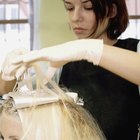
Whether the intent is to cover grays or reinvent your look, it's relatively easy and inexpensive to change hair color. Yet overprocessing hair by bleaching and dyeing is the most common cause of hair damage. Since beauty should not come at the cost of damaging your locks, understanding how hair becomes damaged and what steps you can take to prevent it from happening is essential.
A Close Look at Hair
Each strand of hair is made up of keratin protein, composed of a soft inner structure that is protected by strong, overlapping scales of the outer cuticle. When your hair is colored, the outer scales flare outward to allow the chemicals access to the inner core. Bleaching hair lighter strips the inner strand as it removes pigment from this segment, while coloring hair darker merely adds pigment.
Understanding the Damage
Overuse or improper use of the chemicals in bleach and hair dye weakens the strands and can permanently damage the hair. This often occurs when the color is left on too long, the concentration of chemicals is too high, or the hair is too often subjected to bleach or dye. With the outer scales flared out, not only are you left with a dry and frizzy appearance, but the inner core is no longer protected. The strand is then further susceptible to damage from heating tools, hair products, ultraviolet light and air pollution. This can result in split ends and breakage which are mended only by a haircut.
Prevention During Coloring
There is hope for those who want to color their hair without damaging the locks. Consider patronizing salons that use organic hair color or purchase organic brands for at-home dyeing. These are less damaging to your tresses, not to mention they provide longer lasting color. Choose a color within three shades of your natural hue and, if possible, consider going darker rather than lighter. Semi-permanent dye does not wreak as much havoc on the strands as permanent color, however, should permanent color be necessary, request that your stylist only do a root touch-up rather than coloring the entire length of the hair. Keep an eye on the time so that the dye is not on your hair too long. The stylist should not be distracted or far enough away that you cannot get her attention in case the product causes burning or itching.
Other Ways to Prevent Damage
Short of no longer dyeing your hair, increase the length of time between colorings as much as possible. There is no need to have your hair colored more than every six to eight weeks at most. In addition to using shampoo and conditioner that are specifically for color-treated hair, apply a deep-conditioning treatment once a week. Leave the treatment in the hair for five to 10 minutes before rinsing, or keep it in overnight to wash out in the morning. It's perfectly fine to shampoo every other shower, but processed hair really needs conditioner for hydration.
Related Articles

How to Keep Temporary Dye From Fading

How to Care for a Sewn-in Hair Extension

How to Make Hair Dye More Vibrant

How to Cover Small Amounts of Gray Hair

Products That Relax Curls

How to Care for Hair After a Weave ...

How to Make Extensions Smooth & Silky ...

How to Get a Healthy Spiral Perm

How Long to Wait to Re-Dye Hair

Chi Hair Treatment

Difference Between Permanent Hair Color ...

How Long Does a Hair Texturizer Last?

How Often Can You Color Your Hair at ...

How to Make Coarse & Curly Hair Soft

How to Deep Condition Extensions

Affirm Relaxer Ingredients

How to Correct Uneven Blond Bleaching

The Effects of Perm Lotion on Hair ...

How to Stop Your Hair From Looking Dry ...

What Is Clear Matrix Color Sync?
References
Writer Bio
Pam Smith has been writing since 2005. In addition to her work for Demand Media, her articles have been published online at CBS Local. She also wrote for the Pennsylvania Center for the Book's Literary Map while earning a Bachelor of Arts degree in English at the Pennsylvania State University. She is currently an editorial assistant for Circulation Research.
Photo Credits
Medioimages/Photodisc/Photodisc/Getty Images